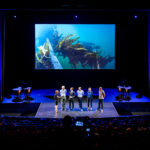
More than 18,000 members of Lions Clubs International (LCI) flooded the streets of downtown Honolulu this past spring in a colorful parade of nationality that is a hallmark of the organization’s annual meeting. The 2015 LCICon, held June 26–30, took over the Hawaii Convention Center and tapped nearly three dozen hotels in the area.
A great piece of SMERF business — involving a social, military, education, religious, or fraternal group? No, just a great piece of business, according to Gloria Geske, CMP, manager of the convention division for LCI. “As one of the country’s oldest fraternal groups, technically we fit into the SMERF category,” Geske said. “But it’s a broad-brush term, and we don’t fit with many of the assumptions that come with it, in particular that SMERF is low-budget business with minimal F&B. Some of our events are elaborate and high-end. Our citywide convention is 5,000 rooms on peak with a variety of price points in the block. Certain delegations prefer budget accommodations, but others prefer higher-end, full-service hotels.”
Still, under the broad-brush definition, a common SMERF characteristic is that most attendees are paying their own way and therefore are highly rate-sensitive. As a result, many groups meet during value dates to get the best deals and rates, and hotels and CVBs look to this sector to help fill holes in their calendars. Particularly in the social and military segments, events are often planned not by professional meeting planners but rather by volunteer leadership that turns over every year or two.
Or at least, that’s been the conventional wisdom around SMERF business. But it’s an older industry term — old enough that not everyone uses it anymore, or means the same thing when they do. “Destinations may define segments of SMERF differently,” said Karl Pietrzak, vice president of sales for VisitPittsburgh. “The ‘E” category for us isn’t education groups but ethnic or multicultural groups.” (See “E Is for Education?,” p. 87.) Tracked over the last five years, SMERF events account for 18 percent of VisitPittsburgh’s group business, tying with sports groups as the second-largest sector. (Associations account for the greatest percentage, at 33 percent.) “This is a very important sector to VisitPittsburgh, and has been for years.”
DEMOGRAPHICS DRIVE CHANGE
Given the amorphous definition of SMERF, statistics are hard to come by. A study conducted several years ago by the travel research firm Phocuswright categorized the segment as group leisure travel, and estimated the total travel spend for SMERF groups booking 20 or more hotel rooms in 2008 to be $20.3 billion. The study also found that the SMERF market was growing faster than association or corporate meetings.
Interestingly, while the state of the economy can have a significant effect on the meetings and memberships of trade and professional associations, as well as on corporate meetings and incentive travel programs, for many SMERF groups, demographics are much more of an influencer. Military reunions are declining in number and size, for example, not because of the economy but because of the aging of World War II, Korean War, and Vietnam War veterans.
Sharon Danitschek is president of Reunion Friendly Network, which connects CVBs and hotels with volunteers who plan military reunions. Even if the volume of business is less than in the past, she said, reunions are still an attractive market segment. Events typically last four to five days, including a day of sightseeing, a banquet, and a memorial service, and can involve as few as 25 attendees or as many as 250. “The great thing about military reunions,” Danitschek said, “is that they are very willing to change dates to get the most affordable rates, and that’s a boon to many destinations and hotels.”
Fraternal service groups such as the Elks and the Order of the Eastern Star (Freemasons) are also seeing declines — because younger people aren’t joining as their parents did — although some service groups are seeing strong membership growth overseas. “Lions Clubs International is approaching its centennial in 2017. Our association is changing with the times,” Geske said. “Our membership has increased in each of the last seven years due to international growth. This has shifted our convention-attendee mix from predominantly American to almost 70 percent international. In addition, our expansion in China, India, and eastern Asia has brought in younger members. Overall, women now represent more than 30 percent of our total membership.”
College sororities and fraternities are also considered part of the SMERF mix. As college enrollment grows, so do sororities’ and fraternities’ memberships, as well as their annual conventions. Indeed, overall interest in Greek life is on the rise. In its 2013–2014 annual report, the National Panhellenic Conference, an umbrella group representing 26 national sorority organizations, reported that the number of sorority initiates grew from 80,000 in the 2004–2005 school year to 131,683 in 2013–2014. Likewise, the North-American Interfraternity Conference, an association representing 74 of the country’s largest fraternities, reported the number of new pledges grew by 45 percent from the 2004–2005 school year to 2012–2013.
Not surprisingly, then, a record number of members — nearly 1,100 — attended the Kappa Delta sorority’s 2015 National Convention, which took place June 27–July 1 at the Walt Disney World Swan and Dolphin Resort. And more than 10,000 members and supporters of the Kappa Alpha Psi fraternity convened in New Orleans on Aug. 11–16 for the group’s 82nd Grand Chapter Meeting, leaving behind a donation of $60,000 in computer technology and equipment in three area schools.
Another socially focused organization that has enjoyed explosive growth is the Red Hat Society (RHS), which got off the ground in 1998 when the two founders held a tea party to celebrate older women and their friendships. Today, RHS has 50,000 members around the world, including women of all ages. Red Hat’s annual International Convention draws about 1,200 attendees, and is typically held during the summer in a top-tier meeting destination, at a convention hotel that can house the entire program under one roof, according to Laura Lara, RHS’s events manager. The 2015 convention was held at the JW Marriott Indianapolis and featured a trip to the Indianapolis Motor Speedway and entertainment by The Marcels. Past entertainers have included Gladys Knight, Dana Carvey, and Damon Wayans.
In terms of sheer numbers of attendees, religious conferences are probably the biggest slice of the SMERF pie. The Religious Conference Management Association’s (RCMA) most recent member study in 2012 estimated that RCMA member conventions accounted for more than 8 million attendees annually. “The United States is one of the most religious countries in the world,” said Harry Schmidt, RCMA’s executive director, “so it’s not surprising that religious conferences are numerous.”
Religious meetings run the gamut from stadium-filling gatherings to church groups that use retreat centers. Many groups bring families, and affordable rates are important, because often delegates are sponsored by individual churches or by the denomination as a whole. “We’re going to meet no matter what the state of the economy,” Schmidt said. “That’s the way faith groups are.”
THE POWER OF PASSION
Tom Hermer is area director of sales for Wyndham Hotels and Resorts, based at the 701-room Wyndham Grand Pittsburgh Downtown, where SMERF meetings account for 35 percent of overall group business. “Every kind of SMERF group comes through our doors,” Hermer said. And while each segment is different, they all share a common characteristic. “If you take the view of 30,000 feet above ground, one of the things that is common is that SMERF attendees are there because they have a personal connection and passion for whatever the organization represents. They’re not in the group as part of their work or professional identity,” Hermer said. “We try very hard as a brand to convey understanding of their passion and why they’re all here and to support that.”
The hotel company also works with groups to find the best value for their business, which the current seller’s market in hotel rooms has made more challenging. Signing multiyear contracts can help insulate groups from big swings in room rates, Hermer said, and groups that can be flexible with dates and arrival patterns may be able to negotiate F&B minimums. One of the trends he is seeing with some SMERF groups is the more frequent use of hotel-room rebates back to the organization to help defray costs. For instance, a group might have a $10 rebate on every room, which creates an incentive to make sure attendees book inside the official block. While rebate strategy isn’t new to the world of association meetings, Hermer noted, it is for SMERF events.
What isn’t new for SMERFs is the vital revenue backbone they offer for many destinations, especially second- and third-tier cities. Pensacola, Florida, is a major market for military reunions, thanks in part to the large number of military-related venues in the area, such as the National Aviation Museum and the Wall South, a half-size replica of the Vietnam Veterans Memorial in Washington, D.C. — to say nothing of the presence of Naval Air Station Pensacola. Hampton, Virginia, offers a convention center with 344,000 square-feet of meeting and exhibit space adjacent to an 11,000-seat coliseum. It’s a combination that makes the destination especially popular with religious groups that need large assembly space as well as conference facilities. Branson, Missouri, draws SMERF groups with its mix of live-entertainment venues, plethora of affordable hotels, and more than 113,000 square feet of function space at the Branson Convention Center, which is the centerpiece of the $490-million Branson Landing development.
“Many of our Branson hotels are a good fit for SMERF — especially some of our mid-level properties,” said Deborah Cohen, CMP, director of meeting and convention sales for the Branson/Lakes Area Convention & Visitors Bureau, which is targeting new SMERF business that includes arts-and-crafts groups and vintage-car and motorcycle enthusiasts. The destination is already popular for military reunions; the bureau has a dedicated salesperson for this market as well as a complimentary RFP service.
Some destinations offer incentives, such as free passes to cultural attractions, discount rates on city-owned venues for special events, or free passes for downtown transportation. For strategic SMERF business, a destination might go further and provide sponsorship or donation dollars to a cause championed by the organization. For example, VisitPittsburgh has created a unique partnership with the National Society of Black Engineers (NSBE) that supports the group’s mission to recruit and retain talented students, according to VisitPittsburgh’s Pietrzak. NSBE held its Annual Convention in Pittsburgh in 2012, and will bring 10,000 attendees to the city for its 2018 meeting. “SMERF attendees have a strong personal connection to their organization,” Pietzak said, “so supporting the group mission can be a powerful incentive.”



